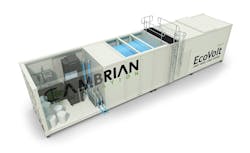After the Clean Water Act (CWA) passed the U.S. Congress in 1972, a flurry of federal funding supported the construction of modern municipal wastewater treatment plants equipped to meet new discharge standards across the U.S. Now, more than 40 years later, the plants are rapidly deteriorating and running low on capacity. In many regions, communities are also faced with another challenge: long and damaging droughts.
Traditional water infrastructure is centralized. Ratepayers typically take a linear approach to water consumption, using water just once before disposal. Conveyance systems then channel spent residential, commercial and industrial water to a central treatment plant. There, outdated technologies – typically aerobic and extremely energy-intensive – treat contaminants from the combined wastewater stream before discharging it to the local ecosystem.
To fund the plants, municipalities often levy myriad fees and surcharges on local food and beverage producers and other industrial businesses with high-volume, high-strength wastewater streams. In a survey of 58 utilities, the National Association of Clean Water Agencies (NACWA) showed that industrial volume-based rates increased by more than 20 percent from 2010 to 20131. These rates, along with extra-strength rates, only continue to increase. On the extreme end of the spectrum, fees in Bend, Oregon, are set to increase by 65 percent over the next two to four years.2
Municipalities in drought-stricken regions also enforce strict water supply restrictions. This, combined with the aforementioned treatment costs, puts food and beverage producers – and in particular craft breweries – in a bind. Because water is one of their main inputs, capped water supply means capped production for breweries. This stagnates revenue growth and leaves brewers unable to meet demand in an increasingly competitive market, while escalating wastewater discharge fees push their costs higher, squeezing away profits.
In this matrix of contending demands and rising costs, local breweries and municipalities often appear to be at odds, with breweries and residents competing for limited resources. Municipalities need to ensure adequate water supply for residents, yet want to encourage commercial and industrial growth. Local breweries need to consume more water to increase production and meet market demand, yet strive to be good corporate citizens and remain invested in their local communities.
Public-private partnerships offer a strong solution, enabling growth through increased water security for breweries and municipalities. Collaborating on and investing in distributed, on-site wastewater treatment solutions can relieve pressure on resource constraints, encourage growth, and keep breweries flourishing among their roots.
The energy-efficient anaerobic-aerobic wastewater treatment solution can remove more than 99.9 percent of contaminants.
Case study: Northern United Brewing Company & the City of Dexter
Michigan-based Northern United Brewing Company (Jolly Pumpkin Artisan Ales, Grizzly Peak Brewing Company, and North Peak Brewing Company) had never had a problem with water. In 2012 when it consolidated its operations – previously split between Traverse City and Dexter – and permanently moved to Dexter, the company was excited for growth and began expanding its facility to accommodate increased production.
Soon after operations began at the new 70,000-square-foot brewery, it became apparent that the City of Dexter’s publicly owned treatment works (POTW) would be hard-pressed to handle the increased volumes of high-strength wastewater Northern United would generate if it continued to increase production. The POTW’s limited capacity inhibited the brewery’s growth and affected the city’s ability to support other businesses because Northern United’s wastewater was using a significant portion of the industrial capacity at the municipal wastewater treatment plant.
Having already consolidated operations in Dexter, relocating to a larger municipality with a larger POTW was not an option. Committed to working with the City of Dexter, Northern United met with city leaders to determine the best way to move forward. After several discussions, the brewery began evaluating on-site wastewater treatment solutions that would allow them to alleviate pressure on Dexter’s POTW. They selected Cambrian Innovation’s modular, containerized anaerobic-aerobic treatment solution designed specifically for small, growing industrial businesses. The energy-efficient solution is designed to remove more than 99.9 percent of contaminants from high-strength wastewater, producing water suitable for discharge or industrial reuse.
In 2013, the Michigan Department of Agriculture & Rural Development (MDARD) began the Strategic Growth Initiative Grant Program in an effort to promote the growth of Michigan’s expanding food and agriculture industry. Cambrian worked with Northern United to apply for the grant, and with strong support from the City of Dexter, the brewery secured support funding from the state. This allowed Northern United to move forward with the purchase and installation of the wastewater treatment solution.
The partnership forged between Northern United Brewing Company and the City of Dexter resulted in a solution that supported not only the brewery’s plans for growth – the brewery now distributes Jolly Pumpkin Artisan Ales internationally – but also the city’s ability to accommodate wastewater from the residential community as well as new Dexter-based industrial businesses. The MDARD is now looking to use this model and technology to attract, retain and grow other food and beverage facilities, such as a cranberry processing facility, in smaller towns across the state.
New business models help to make distributed, on-site wastewater treatment solutions more affordable and accessible.
New partnerships enabled by the infrastructure as a service
Although there are many benefits to distributed, on-site wastewater treatment solutions for food and beverage producers and POTWs, they are often perceived as cost-prohibitive. Without outside funding, food and beverage processors can be hesitant to sink capital into equipment that does not directly affect their product.
New business models such as Cambrian Innovation’s Water-Energy Purchase Agreement (WEPA™) help to make distributed, on-site wastewater treatment solutions more affordable and accessible. Launched in late 2015, the WEPA eliminates up-front capital costs for customers, allowing them to pay for performance on a per-gallon basis.
Under the WEPA, Cambrian assumes responsibility for everything wastewater-related, from design, construction and installation to ownership and operation of treatment solutions. This affords customers more capital, time and energy to focus on their core products and processes, and it eliminates risks associated with ownership and long-term operations.
The WEPA can also facilitate partnerships between industrial businesses and POTWs. Because it does not require an up-front capital investment, the WEPA can help expedite procurement for added capacity at a municipal plant. The POTW does not have to seek funding from the government or issue public bond offerings; it can simply allocate money from its operating budget and pay a monthly service fee for added treatment capacity. This allows the POTW to more quickly accommodate increased wastewater flows from new or growing industrial businesses without disrupting ongoing plant operations.
Conclusion
Public-private partnerships are an innovative way to secure new, distributed wastewater treatment infrastructure for food and beverage producers and municipalities faced with wastewater management challenges. By proactively addressing their resource restrictions, both parties enable collaborative, sustainable growth.
Highly automated solutions and new business models like the WEPA minimize the complexity and costs associated with wastewater treatment while delivering expanded capacity for residents and businesses. This allows industry to grow in smaller cities and towns with limited, aging infrastructure, creating economic growth while increasing resiliency and providing insurance against resource volatility.
REFERENCES
- National Association of Clean Water Agencies, Opportunities & Challenges in Clean Water Utility Financing and Management, February 2015, http://www.nacwa.org/docs/default-source/Legal-Resources/2015-07-31finsurvey-execsum.pdf?sfvrsn=0.
- Wanda Moore and KTVZ, Sewer Hike Rate Hike Brewing, May 12, 2016, posted August 2016, http://www.ktvz.com/news/bend-breweries-facing-65-percent-sewer-rate-hike/39522626.
Claire Aviles is the marketing and communications manager at Cambrian Innovation. She is responsible for the company’s brand identity and messaging, internal and external communications, and marketing content and programs. Aviles has a Bachelor of Arts in English from Boston College, with minor concentrations in economics and music. She can be reached at [email protected].




